|
June
2003
|
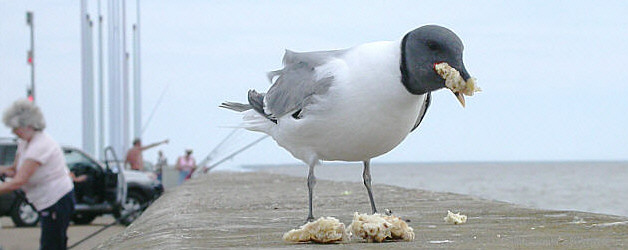 |
|
Sabine's
Gull - Lowestoft Harbour - ©Andrew Easton
|
BLACK-THROATED DIVER Gavia arctica
One flew north past Kessingland at 9:50 on the 3rd.
GREAT CRESTED GREBE Podiceps cristatus
Single birds were on the sea off Kessingland on the 8th and 23rd.
FULMAR Fulmarus glacialis
Lowestoft - 8th (1 S), 10th (1 S).
Kessingland - 1st (1 N, 2 S), 2nd (2 N, 1 S), 3rd (6 N, 2 S), 4th (5 N, 2 S), 5th (2 N, 2 S), 6th (3 N, 4 S), 7th (5 S), 8th (6 N, 1 S), 9th (1 N), 10th (1 N, 1 S), 11th (2 N), 12th (2 N, 2 S), 13th (1 N, 1 S), 14th (5 N, 1 S), 15th (2 N), 16th (6 N), 17th (1 S), 18th (5 N, 1 S), 19th (2 N), 20th (2 N, 2 S), 21st (7 N, 2 S), 22nd (3 N, 2 S), 23rd (4 N), 24th (1), 25th (4 N, 1 S), 26th (9 N), 27th (5 N, 2 S), 28th (2 S).
Highest Day Count = 9 (7 N, 2 S) on the 21st.
Monthly total = 124 (91 N, 33 S).
MANX SHEARWATER
Puffinus puffinus
Northbound birds passed Kessingland on the 19th at 9:20 and 21st at
17:20.
GANNET Morus bassanus
Lowestoft - 1st (1 N), 8th (7 N).
Kessingland - 1st (4 N), 2nd (7 N, 3 S), 3rd (33 N, 1
S), 4th (2 N), 5th (39 N, 3 S), 6th (39 N, 2 S, +1), 7th (23 N, 5 S),
8th (37 N, 6 S), 9th (43 N, 11 S), 10th (35 N, 10 S), 11th (32 N, 1
S), 12th (25 N, 18 S), 13th (16 N), 14th (42 N, 10 S, 2 o/s), 15th (15
N, 3 S), 16th (4 N, 2 S), 17th (12 N), 18th (5 N, 1 S), 19th (24 N,
3 S), 20th (22 N, 4 S), 21st (35 N, 15 S), 22nd (22 N, 13 S), 23rd (22
N, 5 S), 24th (46 N, 12 S), 25th (34 N, 17 S), 26th (40 N, 5 S), 27th
(71 N, 4 S), 28th (30 N, 5 S, +4), 29th (23 N, +3), 30th (20 N, 6 S).
Highest
Day Count = 75
(71 N, 4 S) on the 27th.
Monthly total = 959 (792 N, 165 S, 2 o/s).
CORMORANT Phalacrocorax
carbo
Kessingland - 4th (1 S), 5th (3 N), 6th (2 S), 11th (1
S), 12th (1 S), 20th (1 N), 21st (1 N), 25th (3 S), 26th (1 N, 2 S),
28th (1 N).
GREY HERON Ardea cinerea
One flew in off the sea at Kessingland on the 9th, and one flew
north there on the 23rd.
WHITE-FRONTED GOOSE Anser albifrons
The injured bird was again on Oulton Broad on the 9th and 22nd.
SHELDUCK Tadorna tadorna
Kessingland - 2nd (3 S), 4th (2 S), 18th (2 N).
TEAL Anas crecca
Kessingland - 5th (7 S), 17th (8 S), 22nd (9 S), 23rd (6 S),
26th (6 S), 27th (11 S), 28th (7 N, 6 S).
POCHARD Aythya ferina
A lone male was at Beccles Quay on the 14th.
TUFTED DUCK Aythya fuligula
Noted past Kessingland on the 28th (5 S).
COMMON SCOTER Melanitta nigra
Kessingland - 6th (17 N), 9th (2 S, 2 o/s), 10th (9 N,
6 S), 12th (2 N, 2 S, 2 o/s), 13th (6 N), 15th (1 N), 17th (1 o/s),
18th (7 N, 10 o/s), 19th (2 N), 20th (2 N), 21st (11 N), 22nd (8 S),
26th (2 N, 68 S), 27th (42 N, 28 S), 29th (3 N, 18 S), 30th (2 S).
Highest
Day Count = 70
(42 N, 28
S) on the 27th .
Monthly total = 253 (104 N, 134 S, 15 o/s).
COMMON EIDER Somateria mollissima
Kessingland - One pair south flew south on the
9th, and on the 13th a female was feeding close inshore there.
Lowestoft - A first summer male was at Ness Point on the
evenings of the 11th, 12th and 14th. It was on the rocks extending south
from the South Pier from the 16th-18th.
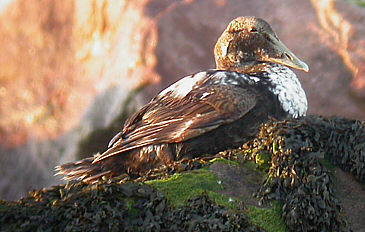 |
|
Eider - Ness Point - ©Robert Wilton |
RED-BREASTED
MERGANSER Mergus serrator
A male and two females flew north at Kessingland on the 14th.
MARSH HARRIER Circus aeruginosus
At 7:40 on the 5th one was watched arriving in off the sea at Kessingland
heading SSW, it was being mobbed by several Herring Gulls.
HOBBY Falco subbuteo
Singletons were recorded at Kessingland Beach on the 8th (S) and
18th (S), Carlton Marshes on the 21st and 22nd, Lowestoft Cemetery on
the evening of the 23rd chasing swifts)..
OYSTERCATCHER Haematopus ostralegus
Lowestoft - 2nd (4 S).
Kessingland - 2nd (1 N, 4 S), 3rd (2 N, 2 S), 4th (1 S),
7th (2 S), 8th (2 S), 12th (1 N), 14th (3 N, 1 S), 17th (2 S), 18th
(2 N, 3 S), 19th (1 S), 20th (1 N), 28th (2 N, 1 S), 29th (2 N, 1 S),
30th (2 N).
AVOCET Recurvirostra
avosetta
Kessingland - 3rd (2 S), 6th (2 S), 16th (2 S).
RINGED PLOVER
Charadrius hiaticula
One was on Lowestoft North Beach on the 12th, with probably the
same one at Ness Point on the 18th.
GREY
PLOVER Pluvialis squatarola
Kessingland - 10th (1 S).
WHIMBREL Numenius phaeopus
Kessingland
- 27th (1 S), 29th (1 N).
CURLEW Numenius arquata
Kessingland - 7th (1 S), 8th (1 S), 9th (1 N), 10th (1 S),
12th (3 S), 14th (1), 15th (4 S), 16th (5 S), 17th (25 S), 18th (2 S),
19th (5 S), 22nd (64 N), 23rd (6 S), 26th (3 S), 27th (15 S), 28th (7
S), 29th (10 S), 30th (2 S).
TURNSTONE Arenaria interpres
Kessingland - 5th (7 N).
ARCTIC SKUA Stercorarius parasiticus
Noted past Kessingland on the 10th (N @ 06:50) and 17th (N @ 17:35).
The relaxed undulating flight was in sharp contrast to the direct,
urgent migratory flight exhibited by previously observed Skuas this
year.
MEDITERRANEAN GULL Larus melanocephalus
Lowestoft
Harbour - 2nd (2nd-sum). An summer plumaged adult present
on the 18th was chased by the Sabine's Gull, surely a rare combination
in high summer!!! The same adult was again there on the 28th.
Kessingland
- 2nd (1 N 2nd-sum), 10th (1 N 2nd-sum), 11th (1 S 2nd-sum), 14th (1
S 2nd-sum), 16th (1 S 2nd-sum), 17th (3 N, 1 S all 2nd sum). Two individuals
were surface feeding a few metres off the beach at Kessingland on the
18th (2 N ad. + 2nd-sum flew north together), 19th (1 S 2nd-sum), 20th
(1 N 2nd-sum), 21st (1 S 2nd-sum), 22nd (2 N ad. + 2nd-sum), 24th (1
S, ad.), 25th (1 S 2nd-sum), 26th (3 N 1st-sum + 2 2nd-sum), 27th (3
N ad. + 2 2nd-sum), 28th (2 N both 2nd-sum).
LITTLE GULL Larus minutus
Kessingland - 2nd (2 N 1st-sum), 6th (1st-sum), 8th (1st-sum
N), 13th (1st-sum), 20th (1st-sum S), 27th (ad. N).
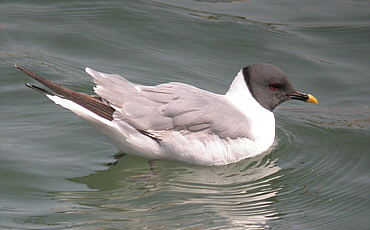 |
|
Sabine's
Gull - Lowestoft Harbour - May 31, 2003 - ©Robert Wincup
|
Hundreds of birders came to Lowestoft to see the spectacular Sabine's Gull in Lowestoft South Pier which remained all month. Roosting on the South Pier entertainment building it spent the day in the immediate vicinity of the South Pier.
Initially when chips or bread were thrown it would only come over when it saw other gulls feeding but did not seem to recognize this as food, although it would eat the bread when it drifted past it later. However it didn't take too long for it to cotton on and is became progressively tamer. To the point where it walk along the wall of the pier to within a metre of people fishing or birders.
Although this species acquires breeding plumage during a complete moult between December and April this individual has failed to replace any of its flight feathers before making the long trek north to the species Arctic breeding grounds. The lack of white tips to faded brown primaries gave this away, and in flight it proved to have extremely worn, almost absent, secondaries and inner primaries. As a result of this the flight action is rather rapid and weak as a result. In addition the wing coverts are a mixture of old, slightly brownish tinged grey feathers and new slaty grey feathers. The tail feathers appear to be almost full grown now, although there is still a gap to be filled.
It preened its wing
feathers very vigorously at times, running them tightly through its
bill, which seems to be reducing them to quills much faster. It calls
frequently, particularly when chasing Black-headed Gulls from its favourite
patch of mud in Children's Corner at low tide. It even started to threatened
a Herring Gull but chickened out two metres away when the Herring Gull
did not move! In flight however it will quite happily, and noisily,
harass the Herring Gulls, though they do occasionally turn the tables
on it.
As breeding plumage is usually attained by the second summer in this
species it seems likely that this individual is very late moulting from
second winter plumage, though it is possible that it is an adult that
has failed to moult correctly.
GREAT BLACK-BACKED GULL Larus marinus
The all white 1st-year bird first seen in April this year was again
in Lowestoft Harbour on the 14th, 15th, 18th, 19th, 20th, 22nd, 27th
and 29th. It was also seen from Carlton Marshes on the 21st, flying
eastwards along Oulton Dyke towards the harbour. It is looked rather
tatty and worn, but at least it is growing new flight feathers, unlike
another gull present! There are now some brownish smudges on the mantle
and a few of the wing coverts, which seem to be the result of white
tips wearing away to reveal brown bases hidden from view before.
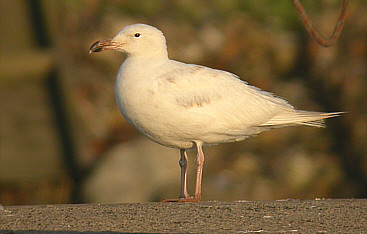 |
|
Great Black-backed Gull - Lowestoft Harbour - June 14, 2003 - ©Robert Wilton |
KITTIWAKE Rissa tridactyla
Kessingland - 1st (2 N, 11 S), 2nd (5 N, 8 S), 3rd (17 N, 6
S), 4th (14 N, 4 S), 5th (7 N, 14 S), 6th (7 N, 6 S), 7th (4 N, 14 S),
8th (6 N, 7 S), 9th (12 N, 7 S), 10th (6 N, 35 S), 11th (2 N, 11 S),
12th (10 N, 20 S), 13th (14 N, 7 S), 14th (7 N, 9 S), 15th (2 N, 5 S),
16th (3 N, 11 S), 17th (2 N, 6 S), 18th (4 N, 5 S), 19th (2 N, 1 S),
20th (3 N, 1 S), 21st (9 N, 4 S), 22nd (1 N, 6 S), 23rd (8 N, 7 S),
24th (7 N, 7 S), 25th (7 N, 2 S), 26th (17 N, 3 S), 27th (9 N, 8 S),
28th (6 N, 9 S), 29th (4 N, 5 S), 30th (1 N, 2 S).
Highest
Day Count =
41 (6 N, 35 S) on the 10th.
Monthly total = 449 (208 S, 241 S).
SANDWICH TERN Sterna sandvichensis
Lowestoft - 1st (2 N), 8th (2 N, 1 S).
Kessingland - 1st (10 N, 4 S), 2nd (3 N, 2 S), 3rd (16
N, 1 S), 4th (15 N, 2 S), 5th (9 N, 10 S), 6th (7 N, 2 S), 7th (6 N,
3 S), 8th (3 N, 6 S), 9th (3 N, 8 S), 10th (5 N, 5 S), 11th (6 N), 12th
(18 N, 3 S), 13th (5 N, 3 S), 14th (10 N, 3 S). 15th (13 N, 7 S), 16th
(10 N, 1 S), 17th (23 N, 4 S), 18th (8 N, 8 S, 2 feeding), 19th (3 N,
4 S), 20th (2 N, 3 S), 21st (11 N, 4 S), 22nd (10 N, 6 S), 23rd (1 N,
5 S), 24th (21 N, 4 S), 25th (30 N, 3 S), 26th (10 N), 27th (23 N, 6
S), 28th (17 N, 18 S), 29th (7 N, 11 S), 30th (4 N, 3 S).
Highest
Day Count =
35 (17 N, 18 S) on the 28th.
Monthly total = 445 (306 N, 139 S, feeding).
COMMON TERN Sterna hirundo
Lowestoft
- The roof nesting colony along Lake Lothing continues to thrive, with
a minimum of eight nests seen (the other side of the roof cannot be
viewed but probably holds a similar number. The adults fish over Oulton
Broad, along Lake Lothing, in the harbour and out to sea. Adults carrying
fish are regularly seen, and heard, taking a short cut from the coast
directly across the town rather than follow Lake Lothing.
Kessingland
- 1st (5 N, 3 S), 2nd (1 N, 3 S, 1 feeding), 3rd (6 N, 3 S, 1 feeding),
4th (8 N, 7 S, 2 feeding), 5th (8 N, 15 S), 6th (13 N, 10 S), 7th (3
N, 9 S), 8th (17 N, 10 S, 1 feeding), 9th (7 N, 4 S, 1 feeding), 10th
(5 N, 5 S, 1 feeding), 11th (2 feeding), 12th (9 S, 2 feeding), 13th
(3 N, 3 S, 1 feeding), 14th (4 N, 5 S, 3 feeding), 15th (6 N, 3 S),
16th (9 N, 3 S), 17th (6 N, 12 S), 18th (5 N, 7 S, 5 feeding), 19th
(4 N, 3 S), 20th (3 N, 7 S, 2 feeding), 21st (7 N, 2 S, 4 feeding),
22nd (5 N, 1 S), 23rd (7 N, 19 S), 24th (10 N, 6 S, 3 feeding), 25th
(6 N, 2 S), 26th (5 N, 1 S), 27th (8 N, 9 S), 28th (6 N, 11 S), 29th
(3 N, 3 S).
Highest Day
Count = 28
(17 N, 10 S, 1 feeding)
on the 8th.
Monthly total = 363 (245 N, 89 S, 29 feeding).
LITTLE TERN Sterna albifrons
Kessingland - 1st (16 N, 17 S, 1 feeding), 2nd (9 N, 14
S), 3rd (6 N, 6 S), 4th (8 N, 1 S), 5th (15 N, 15 S), 6th (6 N, 7 S),
7th (6 N, 12 S), 8th (16 N, 14 S), 9th (9 N, 6 S), 10th (4 N, 14 S),
11th (5 N, 8 S), 12th (13 N, 13 S), 13th (12 N, 10 S), 14th (24 N, 6
S), 15th (15 N, 7 S), 16th (6 N, 7 S), 17th (5 S), 18th (8 N, 6 S, 1
feeding), 19th (1 N, 6 S), 20th (4 N, 8 S), 21st (8 N, 4 S), 22nd (3
N, 1 S), 23rd (9 N, 13 S), 24th (7 N, 4 S), 25th (14 N, 8 S), 26th (2
N, 5 S), 27th (20 N, 12 S), 28th (6 S), 29th (18 N, 7 S).
Highest
Day Count =
34 (16 N, 17 S, 1 feeding) on the 1st.
Monthly total = 538 (269 N, 267 S, 2 feeding).
RAZORBILL Alca torda
Two were seen off Kessingland during the month. On the 2nd one drifted
slowly north on the sea about 100 metres from the beach. Another was
on the sea about 50 metres from the beach on the 22nd before flying
north.
AUK sp. Alcidae
Kessingland: 2nd (1 S), 5th (1 N), 6th (4 N, 3 S), 7th
(5 N, 1 S, 2 o/s), 8th (4 N), 10th (2 N, 1 S), 11th (1 S), 12th (2 N),
14th (1 N), 18th (3 N), 20th (1 N), 21st (15 N), 22nd (9 N, 1 o/s),
23rd (4 N), 24th (5 N), 25th (3 N), 26th (3 N), 27th (2 S).
Highest
Day Count = 15 (15 N) on the 21st
.
Monthly total = 85 (73 N, 9 S, 3 o/s).
TURTLE DOVE Streptopelia turtur
Reports have been very few and far between this year, though noted
at Jay Lane, Lound on the 1st (2) and 6th (1).
TAWNY OWL Strix aluco
Late in the month three juveniles were seen in Oulton Broad and
Gunton Woods.
SWIFT Apus apus
Groups of 20-30 were moving south on the 18th for most of the day.
Between 14:45 and 14:55, 95 moved south past Kessingland.
GREAT SPOTTED WOODPECKER Dendrocopos major
This recently fledged juvenile was noted at Carlton Marshes on the 21st.
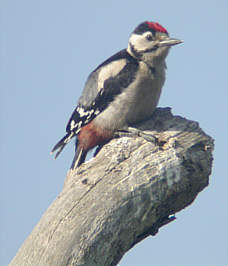 |
|
Great Spotted Woodpecker - Carlton Marshes - June 21, 2003 - ©Andrew
Easton
|
REED WARBLER Acrocephalus scirpaceus
One singing in bushes by the Birds Eye Wall factory on the North Denes
on the 7th.
GARDEN WARBLER Sylvia borin
One was on the slope along Lowestoft North Denes on the 7th.
BULLFINCH Pyrrhula pyrrhula
Noted at Blundeston 17th (1), Carlton Marshes 21st (pr), Gunton 22nd
(1), Borrow Road, Oulton Broad 25th (pr).